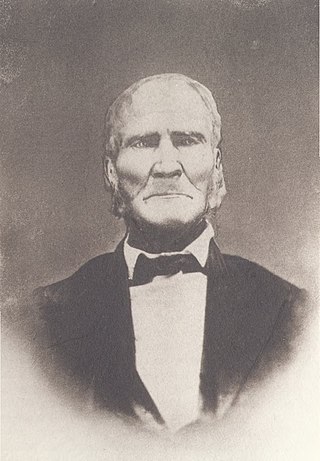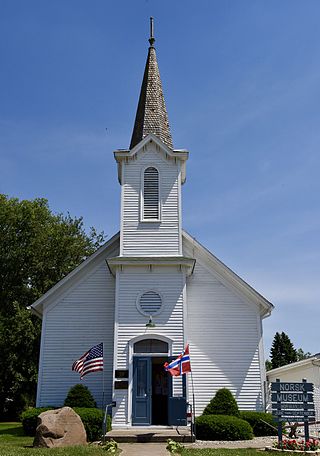| Part of a series on |
| Norwegians |
|---|
 |
| Culture |
| Diaspora |
| Other |
| Norwegian Portal |
Rock Run Settlement was a pioneer settlement in Illinois established in 1839 by Norwegian-Americans. It was named after the town of Rock Run.
| Part of a series on |
| Norwegians |
|---|
 |
| Culture |
| Diaspora |
| Other |
| Norwegian Portal |
Rock Run Settlement was a pioneer settlement in Illinois established in 1839 by Norwegian-Americans. It was named after the town of Rock Run.
The settlement straddled Stephenson County and Winnebago County. The locality was prairie, relieved in parts by timberland. [1]
The foundation of this settlement was accredited to an immigrant from Numedal, who came on the Amelia, in 1839. His name was Clemet Torstenson Stabæk, and he came from Rollaug Parish. With him three others located there in the fall of 1839, namely, Syvert Tollefson and Ole Anderson, from Numedal, and a Mr. Knudson, from Drammen. Stabæk was a man of considerable means. He selected land in Winnebago County, Illinois near Davis, Illinois. His son, Torsten K. O. Stabæk (born in Norway) married Torgen Patterson, and they lived on the farm until 1884, when they moved to Davis. Kristopher Rostad and wife, Kristi, seem also to have moved to Rock Run before the close of 1839. In the following summer came Gunnul Stordok. Stordok lived in Rock Run until 1870; he then moved back to Newark, Wisconsin, where the rest of his relatives who had come to the U.S. had settled. Gunnul Stordok was born in Rollaug, Numedal, in the year 1800; he married Mary Larson (of Rollaug) before emigrating. [1]
Among the earliest arrivals in the settlement subsequently was Halvor Aasen, born in Numedal in 1823, and who came to the U.S. in 1841. For two years after coming to this country, he worked in the lead mines at Mineral Point, Wisconsin, and at Galena, Illinois. In 1843, he married Christie Olson, and bought a farm in Laona Township, Winnebago County, where he and his wife moved in 1844. Here they lived until their death. She died in 1902, and he in March, 1905. [1]
The Rock Run Settlement was prosperous but did not grow to such proportions as other Norwegian-American settlements to the north. In later years, many of its earlier pioneers moved back to Rock County, Wisconsin, as Stordok did, and as Lars Rostad and family also did in the 1860s. Among those who located at Rock Run in the 1840s were Hovel Paulson (born 1817) from North Land Parish, Norway, who located near Davis in 1846; Christian Lunde, also from Land, Norway, came to Rock Run in 1848 and later moved to Goodhue County, Minnesota; Narve Stabæk, Torsten Knudson and Nels Nelson, all three from Numedal; Gunder O. Halvorson, from Kragerø; Svale Nilson, from Bukn Parish, Stavanger; Gunder Halvorson, from Telemarken, and Lars O. Anderson. [1]
In 1848, there were 20 families, 12 unmarried men over 20 years of age, six unmarried women of over 20 years, while there were 32 persons below the age of 20. The whole settlement numbered 90 persons and comprised 4,062 acres (1,644 ha) of land. [2] [1] Two years later, there were 180 families and a population of 942. [3]

Rock County is a county in the U.S. state of Wisconsin. As of the 2020 census, the population was 163,687. Its county seat is Janesville. Rock County comprises the Janesville-Beloit, WI Metropolitan Statistical Area and is included in the Madison-Janesville-Beloit, WI Combined Statistical Area.

Egersund is a town in Eigersund municipality in Rogaland county, Norway. The town is located along the southwestern coast of Norway, about 75 kilometres (47 mi) south of the city of Stavanger. The town is situated along a strait which separates the mainland from the island of Eigerøya. From 1838 until 1964, the town was also an independent municipality.

The Ho-Chunk, also known as Hocąk, Hoocągra, or Winnebago are a Siouan-speaking Native American people whose historic territory includes parts of Wisconsin, Minnesota, Iowa, and Illinois. Today, Ho-Chunk people are enrolled in two federally recognized tribes, the Ho-Chunk Nation of Wisconsin and the Winnebago Tribe of Nebraska. Historically, the surrounding Algonquin tribes referred to them by a term that evolved to Winnebago, which was later used as well as by the French and English. The Ho-Chunk Nation have always called themselves Ho-Chunk. The name Ho-Chunk comes from the word Hocaagra meaning "People of the Sacred Voice". Their name comes from oral traditions that state they are the originators of the many branches of the Siouan language.
Hononegah (c.1814–1847) was the wife of Stephen Mack Jr. an employee for The American Fur Company, a pioneer to the Rock River Valley in northern Illinois and founder of the community of Rockton, Illinois. Hononegah had a strong influence on the Roscoe-Rockton area; the high school of the four towns and the main thoroughfare connecting the towns are both named after her.
Stephen Mack Jr. adventurer and pioneer, American Fur Company employee, founder of Rockton, Illinois.

Samuel Whiteside was an Illinois pioneer. A farmer and backwoodsman, Whiteside briefly served in the Illinois General Assembly after statehood and led the Illinois militia for decades, rising to the rank of general but also enlisting as an ordinary soldier when militia calls declined at the end of wars. Whiteside fought the British in the War of 1812 and Native Americans through the Blackhawk War.

Kittel Halvorson was a U.S. Representative from Minnesota.

Rock Run Township is located in Stephenson County, Illinois. As of the 2010 census, its population was 2,247 and it contained 969 housing units. The villages of Rock City and Davis are located in the township.

The Muskego Settlement was one of the first Norwegian-American settlements in the United States. Situated near today's Muskego, Wisconsin, the Muskego Settlement covered areas within what is now the town of Norway in Racine County, Wisconsin.

James McGowan Strode (1804–1857/1860) was a militia officer and politician from the U.S. state of Illinois. He served in the Illinois militia during the Winnebago War and the Black Hawk War. Strode, originally from Tennessee, lived much of his life in Galena, Illinois. In Galena, during the Black Hawk War he was given command of the 27th Regiment of the Illinois militia and oversaw the construction of a fort in that city. Strode was involved in combat during the war at the infamous Battle of Stillman's Run. In 1835 Strode was elected to represent much of the region of Illinois north of Peoria in the Illinois State Senate.

Norway is an unincorporated community in Mission Township, LaSalle County, Illinois. Located along the Fox River, the community was the site of an early Norwegian-American settlement. Today it is the site of the State of Illinois Norwegian Settlers Memorial.

Colonel Henry Gratiot was a French-American pioneer, farmer, and mill owner. During the Winnebago and Black Hawk Wars, he acted as both an intermediary and early U.S. Indian agent to the Winnebagos throughout the early 19th century. He and his brother Jean Pierre were among the first pioneers to settle in Wisconsin, operating a successful lead mining and lead smelting business, during the 1820s and 1830s. Both, the present-day village of Gratiot, Wisconsin and the town of Gratiot (town), Wisconsin are named in his honor.
Claus Lauritz Clausen was an American pioneer Lutheran minister, church leader, military chaplain and politician.
Jefferson Prairie Settlement was a pioneer colony of Norwegian-Americans located in the Town of Clinton, in Rock County, Wisconsin, United States. This site and the nearby Rock Prairie settlement outside Orfordville served as centers for both Norwegian immigration and developments within the Evangelical Lutheran Church in America. The unincorporated community of Bergen is in the vicinity of Jefferson Prairie Settlement.
Ole Knudsen Nattestad (1807–1886) was a Norwegian-American leader and pioneer immigrant settler. Together with his brother Ansten Nattestad, he played a key role in promoting immigration from Norway and for directing immigrants to southern Wisconsin and northern Illinois.
James Shane Alban was an American lawyer, Wisconsin pioneer, and Union Army colonel in the American Civil War. He died leading the 18th Wisconsin Infantry Regiment at the Battle of Shiloh. He also served as a member of the Wisconsin State Senate.
Halvor Halvorson Haugan Peterson was an American farmer and politician.
The Fox River Settlement was the first permanent Norwegian-American immigrant settlement in the Midwest. It was located in La Salle County, Illinois in Mission and Miller Townships, with a part of Rutland Township. Opinions differ as to when they first arived at the Fox River Settlement with some writers fixing 1835 as the year, Knud Langeland claiming it was 1836, and Prof. Rasmus B. Anderson arguing that it was 1834.
The sobriquet "Slooper" refers to the 52 Norwegians who traveled to the United States in 1825 aboard the sloop Restauration. Within the first 100 years, the Slooper community numbered at least 1,000 persons.
Koshkonong Settlement was a pioneer settlement located in Wisconsin's eastern Dane and western Jefferson counties. It took its name from Koshkonong Lake, and particularly from Koshkonong Creek.